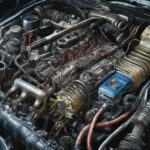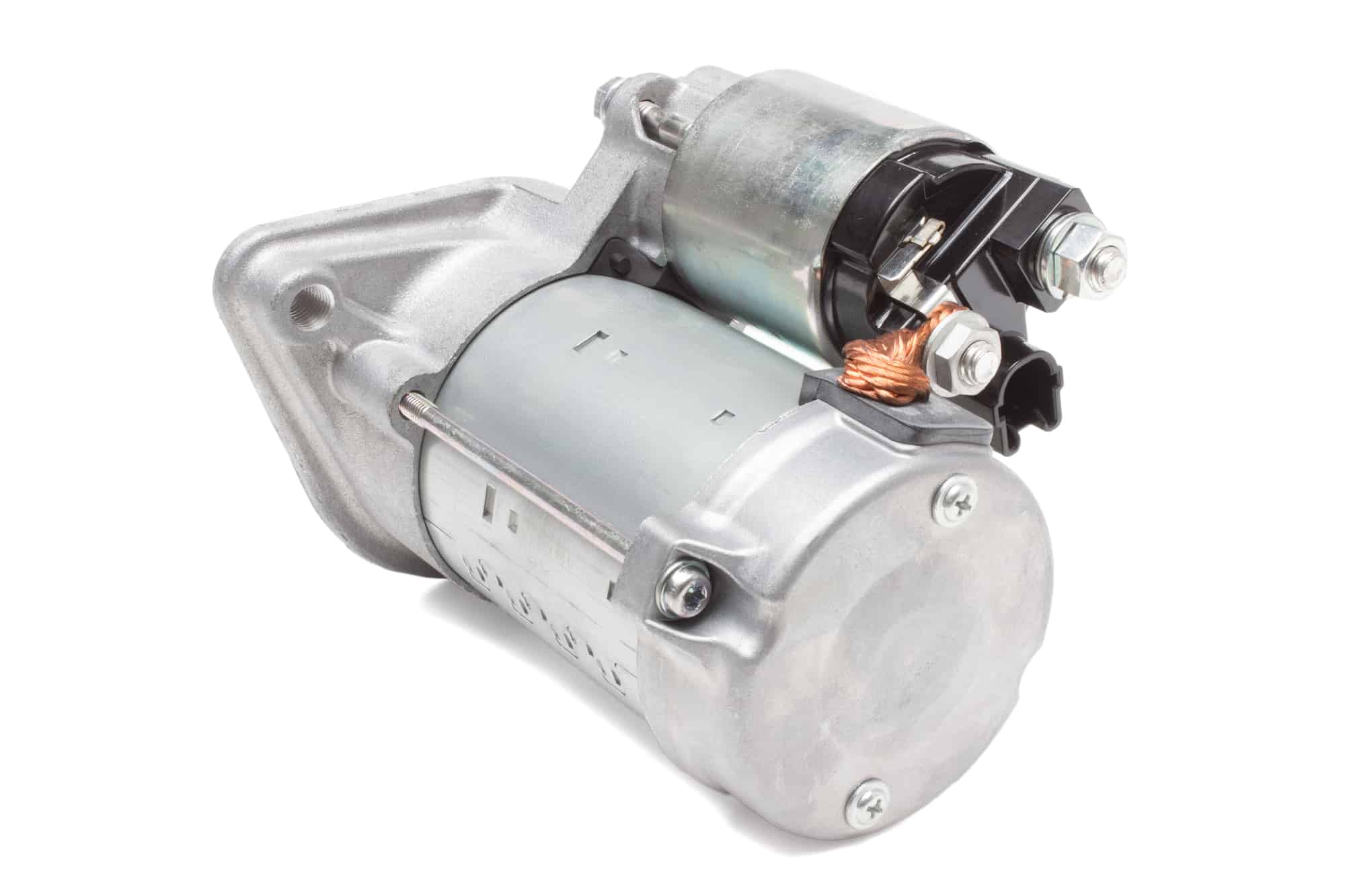The starter motor is responsible for starting the engine by applying a turning force to the engine flywheel. When the starter is running, the starter gear is pushed into contact with the flywheel allowing it to turn over the engine.
If your starter spins but does not engage the flywheel, it is likely due to a faulty starter solenoid or a worn-out starter gear. The starter solenoid is responsible for engaging the starter gear with the flywheel, and if it fails, the starter will spin without engaging the flywheel.
Similarly, if the starter gear is worn out, it may not be able to engage the flywheel properly, causing the starter to spin without turning the engine over.
The starter gear, also known as the starter pinion, is a small gear located on the end of the starter motor’s armature shaft. The starter gear is designed to mesh with the teeth on the engine’s flywheel, which is attached to the crankshaft.
When the starter motor is engaged, the starter gear spins and engages with the flywheel teeth, turning the engine over and starting the combustion cycle.
If the starter gear becomes worn or damaged, it can cause problems with the engine starting.
There are many reasons why a starter motor will spin but is not engaging. Sometimes it can be a simple lack of power or it can be a mechanical problem with the starter motor itself.
Why Is The Starter Spinning But Not Engaging (4 Common Reasons)
A starter that is spinning but not engaging can be caused by a faulty starter clutch, a weak car battery, sticky starter solenoid contacts or if the starter motor bendix is not catching the flywheel.
The starter motor is a simple mechanical device that is designed to turn the flywheel of the engine so as to create enough compression to start the engine.
A starter motor is activated by the starter solenoid. This acts as a switch that turns on the starter motor when you start the ignition. When the solenoid gets the electrical signal, it takes power from the car battery and uses this power to close the starter solenoid contacts and this pushes the starter bendix into place and turns the motor to start the engine.
If the starter is spinning but not engaging then this means that although the motor itself is spinning, it may not be generating enough power to engage the bendix with the flywheel.
When a starter is working properly, a current is applied to the starter solenoid and this allows the coil located inside to generate a magnetic field. This magnetic force moves the contacts that close the high current switch, engaging the starter motor with the flywheel and generating enough force to start the engine.
Here are a few common reasons why the starter will spin but won’t engage or start the engine.
Reason 1. Faulty Starter Motor Bendix
One of the most common symptoms of a starter that is not engaging is a faulty bendix. The starter bendix is made up of the small pinion assembly that is connected to the starter motor body. This pinion moves in and out to engage and disengage the flywheel.
Most of the time if the starter is not engaging, then it is a problem with the bendix not operating as it should. It’s not always a fault with the bendix itself, sometimes it’s a problem with the starter contacts or the power source needed to move the bendix.
If the starter motor bendix is not operating properly you will likely hear a clicking or grinding noise that indicates that it is not engaging with the flywheel as it should. If this happens the car may or may not start properly and the starter bendix may stay out even after the engine has started resulting in a loud noise and possibly smoke if it overheats.
Reason 2. Starter solenoid not working
Another common reason for the starter to spin but not engage is if the starter solenoid is faulty. The solenoid is needed to generate the magnetic field necessary to engage the starter bendix with the flywheel. It’s very common for the solenoid to fail but for the rest of the starter motor to still work. You may be able to hear the starter motor running but the car won’t start and may not be any clicking or grinding noises to indicate anything is wrong.
You may be able to isolate the solenoid as the cause of the problem by checking the ECU for error codes. If you see error codes such as P0615 – Starter Relay Circuit, P0616 – Starter Relay Circuit Low, or P0617 – Starter Relay Circuit High this can point to a problem with the starter solenoid.
Reason 3. starter solenoid contacts sticking
The starter solenoid contacts are another common point of failure on the starter motor. There are lots of different variations of the starter solenoid, but they all contain some form of electrical contacts that are moved by a magnetic field that is generated when power is applied to the solenoid. These contacts are often just a simple metal plate or pins that move forwards and backwards within the solenoid.
Over time they can become corroded and can get stuck in the on or off position. If the contacts don’t move when power is applied to the solenoid (when you turn on the ignition), this will cause the solenoid to spin but the bendix pinion will not move into position so it will not engage with the flywheel.
Similarly, the contacts can get stuck in place, causing the starter to stay engaged, and damaging the bendix and flywheel.
Reason 4. A weak battery (Low battery voltage)
Another often overlooked cause of a starter motor not engaging is a weak or not fully charged battery. All batteries are designed to output a certain amount of power necessary to start the engine. This power output value is referred to as cold-cranking amps (CCA) and it varies from car to car. On most modern cars the CCA is at least 400, and larger vehicles and those with diesel engines may need a battery that can give over 800 CCA.
If the battery is starting to fail or has not been fully recharged after the last engine start, then the amount of starting power it can provide will diminish considerably. When it comes to powering a starter motor, the symptoms of a weak battery include a clicking noise and a starter that spins but fails to engage with the flywheel. A fully charged battery should have a voltage of around 12.6 volts. In most cases, if it is below 12.35 volts, then it is considered to be 50% charge. Once the voltage goes below 12 volts it is unlikely to have enough power to start a modern vehicle.
Starter spins but not engaging – What should you do next?
The starter motor is not always easy to access as it is usually fitted low down on the engine block so that it can engage with the flywheel. If you can hear the starter spinning but it is not engaging or the vehicle is not starting then there are a few simple checks you can carry out before you need to remove the starter from the vehicle.
- Start by checking the battery voltage and connections. One of the first checks you should carry out is to make sure the starter is getting enough power from the battery. Start by checking the battery voltage with a multimeter or voltmeter. The voltage of the battery should ideally be above 12.5V and definitely be above 12V, especially on newer vehicles. If the voltage is in the right range, check that the battery connections are tight and are not corroded. Intermittent starter problems can sometimes be attributed to loose battery connections or corrosion on the battery terminals.
- Check for engine error codes. Another easy way to check for a faulty starter motor or starter solenoid is to run a diagnostic check using an OBD scanner. Common starter motor error codes include P0615, P0616, P0617, P0817 and P0512. If the ECU has stored any starter motor related error codes, clear the codes from memory and try staring the car again. If the problem persists or the error codes reappear, this indicates a problem with the starter motor.
- Check the electrical connections on starter motor. It’s also a good idea to check the wiring looms and electrical connections feeding the starter motor. The wiring can become frayed and brittle over time causing problems with power delivery and short circuits. Most starter motors have two wires feeding them, a smaller grounding connection on the side of the starter and a larger live feed on the end held in place by a large nut. Check that the connections are clean and tight and that the internal wiring is not exposed or touching the engine block.
- Remove the starter motor for inspection. If any of the above tests show up a problem, then you’ll need to remove the starter for further analysis. Start by disconnecting the car battery and then locate the starter. Carefully remove the bolts that hold it onto the engine block and disconnect the wiring loom. You may need to gently tap the starter to break the seal with the engine block. Once removed, inspect the starter bendix and flywheel ring gear for excessive wear. You should also check the starter with a battery to see if it the solenoid is working and activating the motor when power is applied to it.
FAQ – Starter Spins But Not Engaging
1. What does it mean when your starter just spins?
If the starter is just spinning and the car is not starting then this usually means there is a problem with the starter solenoid or the starter pinion. A problem with either part will stop the starter motor from engaging with the flywheel and this will stop the car from starting.
A problem with the starter solenoid could be caused by sticky contacts or a problem with the magnetic coil that is needed to activate the starter bendix.
2. How do you tell if its your starter or your battery?
You can tell if it’s the starter or battery at fault in a few ways. Start by testing the battery with a voltmeter or multimeter to see if there is enough power in the battery to start the car. The voltage should read at least 12V to be certain it will start the engine. If you are unsure about the battery then try jump-starting the car. If the car starts when jump-started then it’s not the starter that is at fault. You could also try charging the battery if you have access to a battery charger.
If the battery appears to have enough power to start the vehicle, then you may need to remove the starter for further inspection, especially if the battery checks out ok and the starter is making a whining or clicking noise when the ignition is turned on.
3. Do starters just stop working?
Yes, starters can just stop working. Usually, a starter solenoid will be the first part to go. This is because the solenoid has a lot of small movable parts that can become corroded over time. The internal contacts can stop moving or the magnetic coil can stop generating enough power to move the contacts if it becomes corroded enough.
The starter motor itself is usually pretty resilient to old age but the moving bendix can become stuck in and not retract when power is removed. This can cause damage very quickly to the bendix and the flywheel causing the starter to break immediately.
4. How do you know if your starter is bad or your alternator?
To test whether the starter is bad or if it is the alternator start by checking the condition of the battery. If the battery is flat or is not charging when the vehicle is running, then it’s almost certainly a problem with the alternator (assuming the battery is able to accept a charge).
If the battery checks out ok, then try to jump-start the vehicle to check if the starter is working. If the car starts ok then check the voltage output of the alternator when the engine is running. It should be at least 2 volts higher than the battery voltage when the engine is off, this is usually around 14.8 volts or higher.
If the vehicle won’t start with a jump start, and the battery is ok then it’s more than likely the starter. If the starter makes a clicking or whining sound when you turn on the ignition, but the engine won’t start then the starter will need to be removed and tested.







I’m having trouble starting my car, and I suspect it might be the starter motor. How can I diagnose if the issue is specifically with the starter motor or if it might be another component causing the trouble?
I recently tried jump-starting my car because it wouldn’t start, thinking it was a battery issue, but it still won’t start. How do I differentiate if the problem is with the starter or the battery?